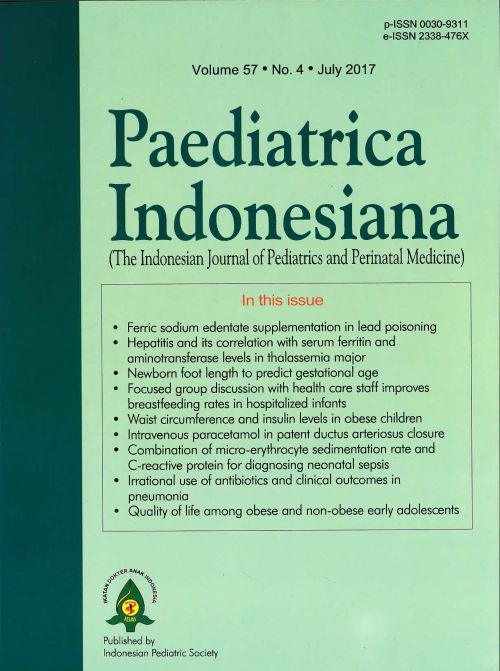Quality of life among obese and non-obese early adolescents
DOI:
https://doi.org/10.14238/pi57.4.2017.216-22Keywords:
obese, early adolescent, health-related quality of life, PedsQLAbstract
Background Obesity in adolescents adversely affects both their psychological as well as their physical health.
Objective To compare the quality of life between obese and non-obese early adolescents, using the PedsQL inventory.
Methods A cross-sectional study was carried out on early adolescents aged 10-12 years among several elementary schools in Denpasar, Bali. Body mass index (BMI) percentiles for age and sex were categorized as obese (BMI ≥95th percentile) and non-obese (BMI <95th percentile). Data on quality of life were collected using PedsQL Generic Core Scales version 4.0 inventory, filled by the children and their parents separately.
Results Total PedsQL score in obese and non-obese group were significantly difference in both reports [child report: mean difference of 9.59 (95%CI 7.14 to 12.05; P<0.05) and parent-proxy report: mean difference at 8.95(95%CI6.64 to 11.26; P<0.05)]. After classifying subjects into impaired and not impaired quality of life based on a total score cut-off <78 as well as other cut-off points for each domain, the individual domains of physical, social, and school function were also significantly associated with obesity (child report: P=0.02, P< 0.001, P=0.018, respectively, and parent-proxy report:P=0.007, P<0.001, P<0.001, respectively). However, emotional function was not significantly associated with obesity (P>0.05). After adjusting for age, gender, and parental education, obesity was significantly associated with PedsQL scores in the child report (OR 7.25; 95%CI 2.94 to 17.89; P<0.05) and the parent-proxy report (OR 10.87; 95%CI 3.83 to 30.84; P<0.05).
Conclusion Obese early adolescents reported significantly poorer quality of life with regards to the physical, social, school function domains and total quality of life than those who were classified into non-obese.
References
Khairy SA, Eid SR, El Hadidy LM, Gebril OH, Megawer AS. The health-related quality of life in normal and obese children. Gaz Egypt Paediatr Assoc. 2016;64:53-60.
Buttitta M, Iliescu C, Rousseau A, Guerrien A. Quality of life in overweight and obese children and adolescents: a literature review. Qual Life Res. 2014;23:1117-39.
Diagnosis, tata laksana dan pencegahan obesitas pada anak dan remaja. In: Dhamayanti, Gultom LC, Hendarto A, Lestari ED, Sidhiarta, Mexitalia M, editors. Rekomendasi Ikatan Dokter Anak Indonesia. Jakarta: UKK Nutrisi dan penyakit Metabolik; 2014.p1-37.
Dewi MR, Sidiartha L. Prevalensi dan faktor risiko obesitas anak sekolah dasar di daerah urban dan rural. Medicina. 2013;44:15-21.
WHOQOL Group. Development of the WHOQOL: rationale and current status. Int J Ment Health. 1994;23:24-56.
Khodaverdi F, Alhani F, Kazemnejad A, KhodaverdiZ. The relationship between obesity and quality of life in school children. Iran J Public Health. 2011;40:96-101.
Satuan Tugas Remaja Ikatan Dokter Anak Indonesia. Tumbuh kembang remaja. In: Dhamayanti M, Endyarni B, Hartono F, Lestari H, editors. Bunga Rampai Kesehatan Remaja. Jakarta: Ikatan Dokter Anak Indonesia; 2010.p.1-28.
Varni JW, Seid M, Rode CA. The PedsQL: measurement model for the pediatric quality of life inventory. MedCare.1999;37:126-39.
Huang IC, Thompson LA, Chi YY, Knapp CA, Revicki DA, Seid M, et al. The linkage between pediatric quality of life and health conditions: establishing clinically meaningful cutoff scores for the PedsQL. Value Health. 2009;12:773-81.
Varni JW, Burwinkle TM, Seid M. The PedsQL 4.0 as a school population healthmeasure: feasibility, reliability,and validity. Qual Life Res. 2006;15:203-15.
Riazi A, Shakoor S, Dundas I, Eiser C, McKenzie SA. Health-related quality of life in a clinical sample of obese children and adolescents. Health and Quality of Life Outcomes. 2010;8:134.
Hughes AR, Farewell K, Harris D, Reilly JJ. Quality of life in a clinical sample of obese children. Int J Obes (Lond). 2007;31:39-44.
Abdel-Aziz EA, Hamza RT, Youssef AM, Mohammed FM. Health-related quality of life and psychological problems in Egyptian children with simple obesity in relation to body mass index. Egypt J Med Hum Genet. 2014;15:149-54.
Saarni C. Emotional development in childhood. Encyclopedia on early childhood development. California: Sonoma State University; 2011.p.1-6.
Rankin J, Matthews L, Cobley S, Han A, Sanders R, Wiltshire HD, et al. Psychological consequences of childhood obesity: psychiatric comorbidity and prevention. Adolesc Health Med Ther. 2016;7:125-46.
Bell LM, Curran JA, Byrne S, Roby H, Suriano K, Jones TW, et al. High incidence of obesity comorbidities in young children: a cross-sectional study. J Pediatr Child Health. 2011;47:911-7.
Taylor A, Wilson C, Slater A, Mohr P. Self-esteem and body dissatisfaction in young children: associations with weight and parenting style. Clin Psychol. 2012;16:25-35.
Chan CM, Wang WC. Quality of life in overweight and obese Chinese children: a mixed-method study. Health Qual Life Outcomes. 2013;11:33.
Williams J, Wake M, Hesketh K, Maher E, Waters E. Health-related quality of life of overweight and obese children. JAMA. 2005;293:70-6.
Jansen PW, Mensah FK, Clifford S, Nicholson JM, Wake M. Bidirectional associations between overweight and health-related quality of life from 4-11 years: longitudinal study of Australian children. Int J Obes Lond. 2013;37:1307-13.
Walders-Abramson N, Nadeau KJ, Kelsey MM, Schmiege SJ, Ellert S, Cejka A, et al. Psychological functioning in adolescents with obesity co-morbidities. Child Obes. 2013;9:319-25.
Halfon N, Larson K, Slusser W. Associations between obesity and comorbid mental health, developmental, and physical health conditions in a nationally representative sample of US children aged 10 to 17. AcadPediatr. 2013;13:6-13.
Madowitz J, Knatz S, Maginot T, Crow SJ, Boutelle KN. Teasing, depression and unhealthy weight control behaviour in obese children. Pediatr Obes. 2012;7:446-52.
Downloads
Published
How to Cite
Issue
Section
License
Authors who publish with this journal agree to the following terms:
Authors retain copyright and grant the journal right of first publication with the work simultaneously licensed under a Creative Commons Attribution License that allows others to share the work with an acknowledgement of the work's authorship and initial publication in this journal.
Authors are able to enter into separate, additional contractual arrangements for the non-exclusive distribution of the journal's published version of the work (e.g., post it to an institutional repository or publish it in a book), with an acknowledgement of its initial publication in this journal.
Accepted 2017-08-31
Published 2018-01-05














